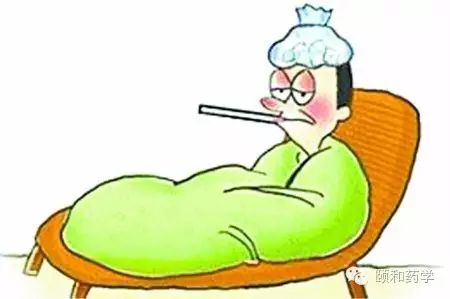
Differences Between Wind-Heat and Wind-Cold Colds
To the general public, a cold is just a cold, typically characterized by upper respiratory symptoms, sweating, and taking some cold medicine to feel better. However, from the perspective of Traditional Chinese Medicine (TCM), the common Wind-Heat cold and Wind-Cold cold are different, and if treated “inappropriately,” the condition may worsen.
Wind-Heat Cold: This occurs when the body is affected by Wind-Heat pathogenic factors, leading to a cold. The main symptoms include excessive sweating, nasal congestion with yellow discharge, a red tongue, sore and swollen throat, and thirst. Patients with Wind-Heat colds often have a rapid pulse, with some rates exceeding 100 beats per minute.
Wind-Cold Cold: This is generally caused by the influence of Wind-Cold pathogenic factors, often presenting as a fear of cold, chills, and a tendency for the skin to develop goosebumps. Wind-Cold colds are often triggered by exposure to cold winds, and even in hot summer weather, one can catch a Wind-Cold cold, primarily due to two reasons: air conditioning and cold drinks.
Four Major Reasons for Wind-Heat Colds in Summer
During hot summer weather, individuals suffering from Wind-Heat colds often report symptoms such as dizziness, nasal congestion, irritability, and fatigue, occasionally accompanied by chills and fever.
Experts analyze that there are four main reasons for developing Wind-Heat colds:
In high-temperature environments, the body sweats more, leading to significant energy consumption from sweat gland secretion, making it easy to “catch a cold”;
Long days and short nights, along with sultry weather, affect sleep and rest, leading to insufficient sleep and decreased immunity, making one more susceptible to illness;
In summer, many people experience a reduced appetite, primarily consuming light foods, which affects protein intake;
Due to the heat, many children on summer vacation and retired elderly individuals are reluctant to exercise, reducing their physical activity and spending long periods indoors in air-conditioned environments.
The prevalence of colds in summer is largely related to the body’s impaired heat dissipation in high-temperature environments. Hot weather and excessive sweating can easily lead to fatigue and lethargy, making the body vulnerable to viral invasion and colds. Additionally, during scorching days, people often seek coolness excessively, which can lead to catching a cold.
Some individuals rush in, drenched in sweat, and immediately take a cold shower, while others may cool off in front of a fan or set the air conditioning to a very low temperature. These behaviors significantly increase the likelihood of developing Wind-Heat colds.
How to Prevent Wind-Heat Colds?
Preventing Wind-Heat colds requires more than just hydration; citizens who are active outdoors or at work should also appropriately supplement with saline to replenish necessary salts and combat fatigue.
Moreover, one should learn to self-regulate and use air conditioning scientifically and reasonably. Due to the large temperature difference between indoors and outdoors and poor indoor ventilation, people in air-conditioned environments are more prone to catching colds. The hotter the weather, the more conscious individuals should be about enhancing their heat tolerance and reducing time spent in air-conditioned rooms. If working in an air-conditioned environment during the day, it is advisable to ventilate and use fans at home, minimizing air conditioning use.
Consuming too much salty or sweet food may also lead to an increase in Wind-Heat colds. In a high-temperature environment, excessive intake of salty foods can reduce saliva secretion, leading to upper respiratory infections; while consuming too many sugary foods can deplete the body’s water and vitamins, causing dry mouth and decreased immunity, resulting in colds. Smoking and drinking can also lower respiratory defense mechanisms, making one more susceptible to illness.
Additionally, working long hours in high temperatures will certainly increase the risk of Wind-Heat colds. Clinically, many otherwise healthy patients have developed Wind-Heat colds due to prolonged overtime or frequent business trips, leading to excessive fatigue and decreased immunity.
In summary, ensuring adequate rest, avoiding late nights, paying attention to heat prevention and cooling, and maintaining a balanced and nutritious diet can effectively prevent the onset of Wind-Heat colds.
Do Not Rush to IV Fluids or Antibiotics at the First Sign of Fever
Many patients have a common “experience” of rushing in and telling the doctor, “Give me an injection or IV, I need to recover quickly; I can’t take leave, I have to work tomorrow.” In reality, this approach is not advisable. Many patients share a consensus that taking antibiotics or IV fluids can “quickly resolve” cold symptoms, unaware of the potential drawbacks.
The course of a cold typically spans several days, and one should respect the natural progression of the illness. IV fluids can effectively address issues of dehydration and electrolyte loss, helping to restore strength, but some patients may experience allergic reactions or other adverse effects from IV therapy; antibiotics are also not recommended for casual use, especially within the first three days of illness, to minimize the risk of side effects and antibiotic resistance. Therefore, it is best to treat Wind-Heat colds with oral rehydration and oral medications.
As long as Wind-Heat colds do not lead to other complications, such as significant discomfort in the head or body, or prolonged high fever, patients can generally recover within a week with some antipyretic and analgesic medications, along with adequate rest.
Drink plenty of water; we always emphasize this to cold patients because the body’s demand for water is significantly higher in hot weather, and fever during a cold further depletes bodily fluids, so it is essential to replenish water in a timely and sufficient manner.

